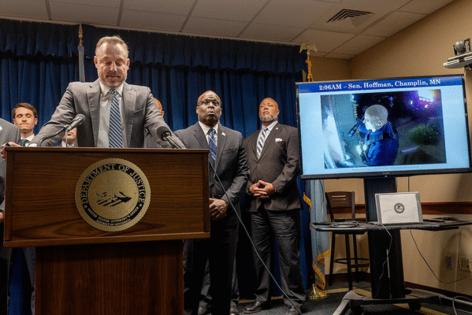Death penalty case against man charged in lawmaker shootings would be rare in Minnesota history
Published in News & Features
MINNEAPOLIS — The decision by federal authorities to charge Vance Boelter with both stalking and the use of a firearm for the murders of Rep. Melissa Hortman and her husband, Mark, raises the potential for a death sentence, a rarity in Minnesota.
“Will we seek the death penalty? It’s too early to tell,” Joe Thompson, acting U.S. Attorney for the district of Minnesota, said during a news briefing announcing the charges against Boelter. “That is one of the options for several of the charges though.”
Minnesota has no death penalty, but capital punishment is legal under federal law. Boelter, 57, of Green Isle, Minn., is charged with six federal crimes, including stalking and murder, in the killing of the Hortmans and the shooting of Sen. John Hoffman and his wife, Yvette. The charges say he posed as a police officer in approaching their homes overnight June 14.
Under criminal statutes, to convict someone of federal first-degree murder the crime must be committed with “malice aforethought.”
That element of premeditation in the killings is a clear part of the criminal complaint against Boelter.
It alleges that one of the notebooks found in Boelter’s SUV contained extensive notes on politicians culled from online search engines that can be used to find “home addresses, phone numbers, and information about family members.”
Other notebooks found at a home associated with Boelter had biographical details about Hortman, including a note which read, “Big house off golf course 2 ways in to watch from one spot.”
Federal first-degree murder charges can also be used in acts of domestic terrorism.
To prove that, prosecutors would need to show that Boelter killed Hortman in a way intended to either intimidate a civilian population, influence government policy by intimidation or affect the conduct of government by assassination.
Asked by reporters Monday why Boelter hadn’t been charged with domestic terrorism, Thompson said the investigation is continuing.
“We brought the charges we think are appropriate right now,” he said. “Obviously these crimes are about 48 hours old, so we have an ongoing investigation. I can’t comment as to what other charges may or may not be brought.”
Minnesota abolished the death penalty in 1911, five years after a botched hanging. The Death Penalty Information Center notes that from 1860-1906, Minnesota executed 27 people.
The most notable execution in state history was the hanging of 38 members of the Dakota tribe by the federal government in Mankato following the U.S.-Dakota War of 1862.
Prior to last weekend, federal prosecutors were already pursuing the death penalty in a case watched around the world with a Minnesota connection.
U.S. Attorney General Pam Bondi has said that the government will seek the death penalty against Luigi Mangione for the killing of Brian Thompson, the UnitedHealth executive and Maple Grove resident gunned down in New York City last year.
The closest the state has come to a death penalty case in recent memory was the federal conviction in North Dakota of Alfonso Rodriguez Jr. for the murder of Dru Sjodin.
Sjodin went missing on November 22, 2003, in North Dakota. Rodriguez Jr., a registered sex offender in Minnesota, was arrested days later. Five months after his arrest, Sjodin’s body was found outside Crookston, Minn.
Rodriguez Jr. was charged with Sjodin’s muder under the Federal Kidnapping Act. It was the first death penalty trial in the history of North Dakota. He was convicted for Sjodin’s murder in 2006 and sentenced to death in 2007.
The sentence was changed to life in prison without the possibility of parole after it came to light that the testimony of Dr. Michael McGee, the Ramsey County chief medical examiner, was “unreliable, misleading and inaccurate.”
Craig Bjork committed some of the most heinous crimes in Twin Cities history when he strangled a woman during sex, then killed his sons Jason and Joey, ages 1 and 3, and later killed his then-girlfriend. He said that he had willed his soul to the devil.
Given three life sentences, Bjork later killed a man in Stillwater prison then was transferred to a prison in Oregon where he killed another man.
In 2019, as he was set to stand trial in Oregon with the possibility of a death sentence, the state’s governor signed a new death penalty law making him ineligible for the punishment.
There are currently three men on death row in federal prisons: Dzhokhar Tsarnaev, the Boston Marathon bomber; Dylan Roof, convicted in the 2015 mass shooting at a Black church in South Carolina that killed nine congregants; and Robert Bowers, found guilty in the 2018 shooting at a Pittsburgh synagogue that killed 11 members.
In 2024, former President Joe Biden commuted the death sentences of 37 of the 40 people who were facing execution by the federal government.
According to the Death Penalty Information Center, 16 people have been executed by the federal government since the death penalty was reinstated in 1988.
Thirteen of those executions were carried out in the final six months of President Donald Trump’s first term in office.
In January of this year, Trump signed an executive order titled, “Restoring the Death Penalty and Protecting Public Safety,” which called capital punishment “an essential tool for deterring and punishing those who would commit the most heinous crimes and acts of lethal violence against American citizens.”
_____
©2025 The Minnesota Star Tribune. Visit at startribune.com. Distributed by Tribune Content Agency, LLC.







Comments